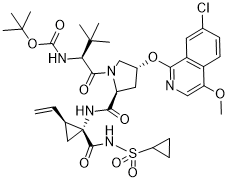This product is for research use only, not for human use. We do not sell to patients.

| Size | Price | Stock |
|---|---|---|
| 100mg | $1050 | Check With Us |
| 250mg | $1950 | Check With Us |
| 500mg | $2925 | Check With Us |
Cat #: V3153 CAS #: 630420-16-5 Purity ≥ 98%
Description: Asunaprevir (formerly BMS-650032; BMS-650032; trade name in Japan and Russia: Sunvepra) is a potent and orally bioavailable small molecule inhibitor of the hepatitis C virus (HCV) NS3 (non-structural) protease that has been approved for use in Japan as part of a combination treatment for HCV infections. It inhibits HCV NS3 protease with an IC50 of 0.2 nM-3.5 nM. HCV serine protease NS3 is required for protein processing during viral replication. Asunaprevir is an experimental drug candidate for the treatment of hepatitis C. It is being tested in combination with pegylated interferon and ribavirin, as well as in interferon-free regimens with other direct-acting antiviral agents including daclatasvir. It is currently in Phase III clinical trials.
Publications Citing InvivoChem Products
Product Promise

- Physicochemical and Storage Information
- Protocol
- Related Biological Data
- Stock Solution Preparation
- Quality Control Documentation
| Molecular Weight (MW) | 748.29 |
|---|---|
| Molecular Formula | C35H46ClN5O9S |
| CAS No. | 630420-16-5 |
| Storage | -20℃ for 3 years in powder formr |
| -80℃ for 2 years in solvent | |
| Solubility In Vitro | DMSO: >100 mg/mL (133.6 mM)r |
| Water: < 1 mg/mLr | |
| Ethanol: >100 mg/mL (133.6 mM) | |
| SMILES Code | O=C(OC(C)(C)C)N[C@H](C(N1[C@H](C(N[C@@]2(C(NS(=O)(C3CC3)=O)=O)[C@H](C=C)C2)=O)C [C@@H](OC4=NC=C(OC)C5=C4C=C(Cl)C=C5)C1)=O)C(C)(C)C |
| Synonyms | BMS-650032; BMS 650032; BMS650032; trade name in Japan and Russia: Sunvepra |
| Protocol | In Vitro | In vitro activity: Asunaprevir (ASV) inhibits the NS3 proteolytic activity of genotype 1a (H77 strain) and genotype 1b (J4L6S strain), with IC50s of 0.7 and 0.3 nM, respectively. The EC50s of ASV against replicons encoding the NS3 protease domains representing genotypes 1a, 1b, and 4a, range from 1.2 to 4.0 nM. Replicon cells are maintained under selective pressure with asunaprevir at concentrations of 10 and 30 times the EC50 values (50 or 150 nM final concentrations, respectively). For genotype 1b resistance selection, replicon cells are maintained in the presence of asunaprevir at 10 or 30 times the EC50 values (30 or 90 nM final concentrations, respectively). Asunaprevir, administered at single or multiple doses of 200 to 600 mg twice daily, is generally well tolerated, achieving rapid and substantial decreases in HCV RNA levels in subjects chronically infected with genotype 1 HCV. Kinase Assay: Asunaprevir (ASV) inhibits the NS3 proteolytic activity of genotype 1a (H77 strain) and genotype 1b (J4L6S strain), with IC50s of 0.7 and 0.3 nM, respectively. The EC50s of ASV against replicons encoding the NS3 protease domains representing genotypes 1a, 1b, and 4a, range from 1.2 to 4.0 nM. Cell Assay: Cytotoxicity is determined by incubating cells (3,000 to 10,000 cells/well) with serially diluted test compounds or DMSO for 5 days (MT-2 cells) or 4 days (all other cell types). Cell viability is quantitated using an MTS assay for MT-2 or a Cell-Titer Blue reagent assay for HEK-293, HuH-7, HepG2, and MRC5 cells, and 50% cytotoxic concentrations (CC50s) are calculated. For the HCV and BVDV replicon assays, CC50s are determined from the same wells that are later used to determine EC50s. |
|---|---|---|
| In Vivo | Asunaprevir (ASV, 3-15 mg/kg, p.o.) displays a hepatotropic disposition (liver-to-plasma ratios ranging from 40- to 359-fold across species) in several animal species. Twenty-four hours postdose, liver exposures across all species tested are ≥110-fold above the inhibitor EC50 observed with HCV genotype-1 replicons. | |
| Animal model | Mice (n=9 per group; overnight fast) receive Asunaprevir (ASV) by oral gavage (5 mg/kg; vehicle of PEG-400-ethanol, 9:1). | |
| Formulation | Formulated in PEG-400:ethanol, 9:1 (mice, rats); 85% PEG-400, 15% water (Dogs, monkeys) | |
| Dosages | 5 mg/kg (mice); 3, 5, 10, and 15 mg/kg (rats); 3 or 6 mg/kg (Dogs); 3 mg/kg (Monkeys); P.O. |
| Solvent volume to be added | Mass (the weight of a compound) | |||
|---|---|---|---|---|
| Mother liquor concentration | 1mg | 5mg | 10mg | 20mg |
| 1mM | 1.3364 mL | 6.6819 mL | 13.3638 mL | 26.7276 mL |
| 5mM | 0.2673 mL | 1.3364 mL | 2.6728 mL | 5.3455 mL |
| 10mM | 0.1336 mL | 0.6682 mL | 1.3364 mL | 2.6728 mL |
| 20mM | 0.0668 mL | 0.3341 mL | 0.6682 mL | 1.3364 mL |
This equation is commonly abbreviated as: C1 V1 = C2 V2
- (1) Please be sure that the solution is clear before the addition of next solvent. Dissolution methods like vortex, ultrasound or warming and heat may be used to aid dissolving.
- (2) Be sure to add the solvent(s) in order.




































